Advancement offices at colleges, universities, and independent schools face mounting pressure to increase fundraising results while working with limited resources and declining alumni participation rates. According to the Council for Advancement and Support of Education (CASE), alumni giving participation rates at U.S. colleges and universities have declined from 18% in 2009 to just 8.5% in 2021, creating urgent challenges for institutions dependent on philanthropic support to fund scholarships, facilities, programs, and operations.
An interactive advancement solution—particularly digital recognition displays and touchscreen technology—offers a powerful approach to addressing these challenges by creating engaging donor experiences, streamlining recognition processes, and building lasting emotional connections between institutions and their constituents. These sophisticated platforms go far beyond traditional plaques or donor walls to create compelling interactive experiences that strengthen relationships, demonstrate impact, and inspire continued philanthropic support.
This comprehensive guide explores how interactive advancement solutions transform institutional fundraising, alumni relations, and donor stewardship through technology—providing educational institutions with practical strategies for implementation, content development, measurement, and long-term success.
Understanding Interactive Advancement Solutions
Interactive advancement solutions encompass a range of digital technologies designed specifically to support fundraising, alumni engagement, and donor recognition in educational settings. While these solutions can include constituent relationship management (CRM) systems, email marketing platforms, and communication tools, this guide focuses on interactive recognition displays as a particularly powerful yet often overlooked advancement solution.
What Makes an Advancement Solution “Interactive”?
Traditional advancement approaches rely on static, one-way communication—printed donor lists, fixed plaques, annual reports mailed to constituents, and newsletters with limited engagement opportunities. Interactive solutions create dynamic, two-way experiences where constituents actively participate rather than passively receive information.
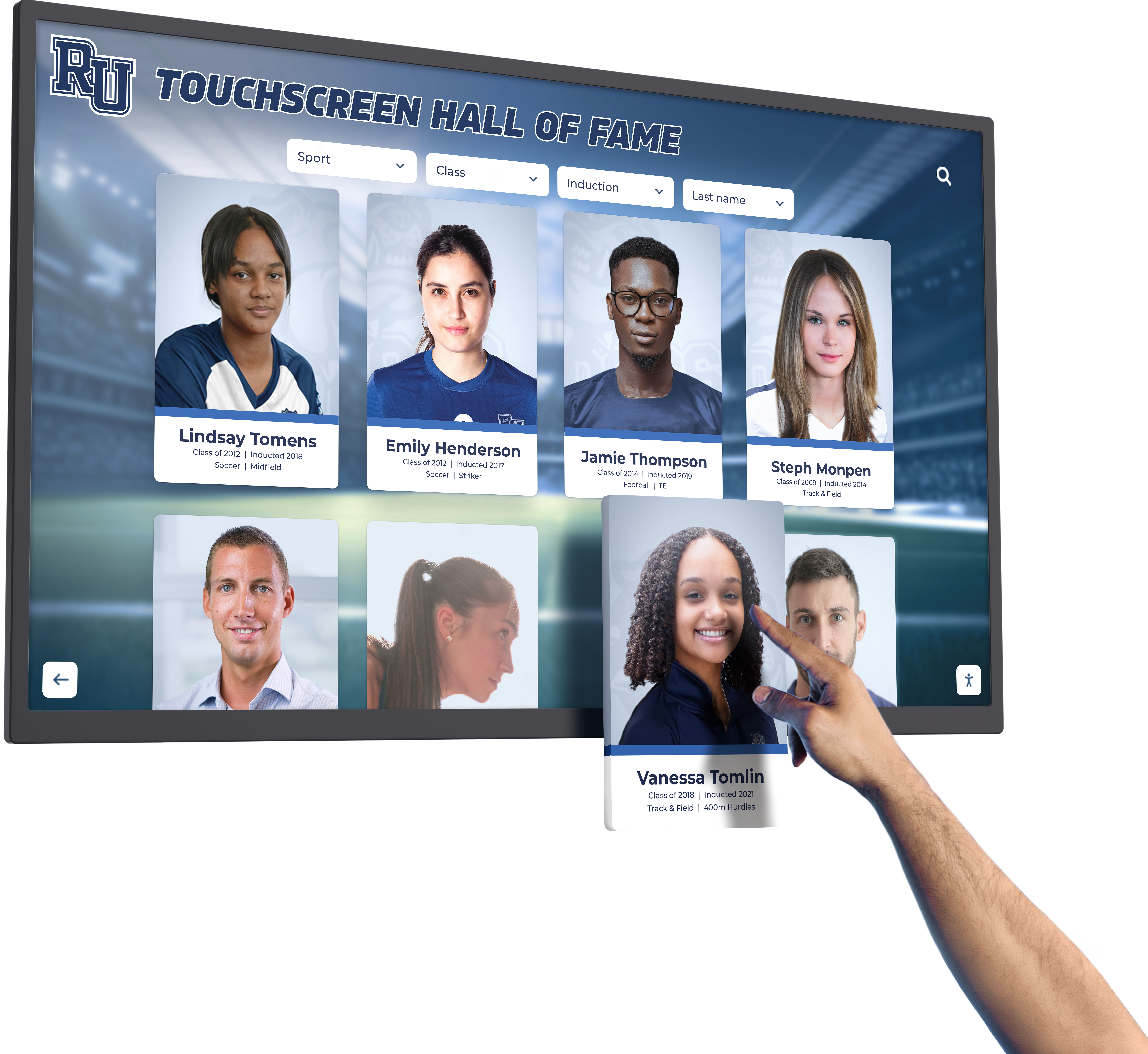
Key Interactive Elements:
Interactive touchscreen displays enable visitors to explore content at their own pace, searching for specific individuals, filtering by categories or time periods, and discovering connections between donors, alumni, and institutional impact. Digital platforms provide immediate feedback to user actions through responsive interfaces, personalized content recommendations, and real-time information updates.
Integration capabilities connect recognition displays with advancement databases, automatically updating donor information, giving levels, and recognition status without manual intervention. Multi-channel accessibility extends recognition beyond physical campus locations through web portals, mobile applications, and social media integration that reaches constituents wherever they are.
Analytics and insights track user engagement patterns, content performance, and interaction behaviors—providing advancement teams with data-driven intelligence to optimize strategies and demonstrate program effectiveness.
Core Technology Components
Modern interactive advancement solutions integrate several key technologies creating seamless experiences:
Professional-Grade Touchscreen Hardware: Commercial displays ranging from 43 to 86 inches provide intuitive interaction through multi-touch gestures, responsive feedback, and durability rated for continuous institutional use. Unlike consumer-grade screens, these displays withstand heavy usage patterns common in high-traffic campus locations.
Cloud-Based Content Management: Intuitive platforms enable advancement staff to add new donors, update recognition information, schedule content rotations, and manage permissions without requiring technical expertise or IT support. Cloud architecture eliminates server maintenance while enabling remote access from any device.
Multimedia Capabilities: Support for photos, videos, audio, documents, and interactive graphics enables rich storytelling that brings donor impact to life through multiple content formats that engage visitors emotionally and intellectually.
Search and Discovery Features: Powerful search functionality, advanced filtering, auto-complete suggestions, and intelligent content recommendations transform how visitors explore recognition content—making discovery intuitive even in databases containing thousands of profiles.
Integration Architecture: API connections and data synchronization capabilities enable seamless integration with existing advancement systems including Raiser’s Edge, Blackbaud, Salesforce, and other common CRM platforms used in educational advancement offices.
Strategic Benefits for Institutional Advancement
Interactive advancement solutions deliver measurable benefits across multiple institutional priorities extending far beyond simple donor recognition.
Strengthening Donor Relationships and Stewardship
Effective donor stewardship requires consistent, meaningful communication demonstrating appreciation and impact. Interactive recognition creates continuous stewardship touchpoints operating 24/7 without ongoing staff involvement.
Always-On Donor Appreciation: Digital donor walls function as perpetual stewardship vehicles recognizing contributions continuously without requiring individual staff action for each interaction. When donors visit campus or access displays remotely, they see their recognition alongside impact stories showing how contributions made tangible differences.
This continuous recognition proves particularly valuable for donors who may not receive frequent personal contact from advancement officers. Annual fund contributors, lapsed donors considering renewal, and prospects evaluating their first gifts all benefit from seeing institutional recognition practices and understanding how their participation would be acknowledged.
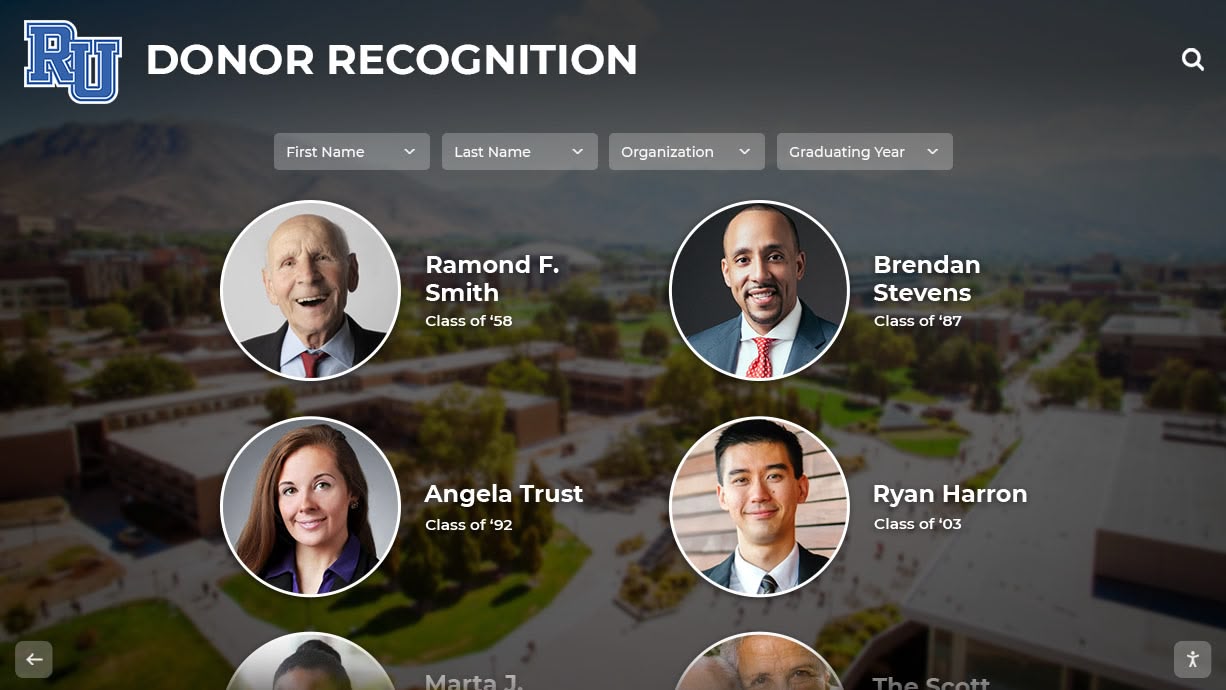
Demonstrating Tangible Impact: Interactive platforms enable advancement teams to tell compelling impact stories through multimedia content that brings giving outcomes to life in ways traditional plaques cannot match. Profiles can include photos of students benefiting from scholarships, videos showing facilities that gifts made possible, testimonials from program participants, and infographics illustrating aggregate campaign impact.
When donors see the faces of students their scholarships supported or virtually tour facilities their gifts created, the connection between giving and impact becomes viscerally real in ways that strengthen ongoing commitment and inspire increased support.
Scalable Recognition Capacity: Physical wall space constraints force difficult recognition threshold decisions when donor walls reach capacity. Interactive systems accommodate unlimited donor profiles without space limitations—whether recognizing 50 donors or 5,000, the physical footprint remains constant.
This unlimited capacity enables truly comprehensive recognition honoring every contributor at every giving level without forcing institutions to raise minimum recognition thresholds, exclude deserving donors, or undertake expensive facility expansions. The ability to recognize broadly while maintaining appropriate distinction for leadership gifts supports both inclusive participation goals and major gift cultivation strategies.
Enhancing Alumni Engagement Through Digital Experiences
Alumni engagement provides the foundation for sustained fundraising success. Research consistently shows that engaged alumni give at significantly higher rates and larger amounts than disconnected alumni. Interactive advancement solutions create compelling engagement opportunities that strengthen institutional bonds.
Personalized Discovery Experiences: Unlike static displays forcing sequential browsing, interactive platforms enable personalized discovery where visitors search for classmates, explore specific time periods, filter by achievement categories, or follow content recommendations based on their interests and connections.
This personalized exploration keeps visitors engaged significantly longer—institutions report average interaction times of 6-8 minutes with interactive displays compared to 30-60 seconds with traditional recognition, creating more meaningful engagement opportunities.
Remote Accessibility for Distributed Constituents: Alumni and donors living far from campus can view their recognition through web-based access to the same content displayed on campus—maintaining engagement regardless of geographic distance. This remote accessibility proves essential for institutions with geographically distributed alumni populations where many supporters may never physically return to campus.
Web-based recognition extensions transform physical displays from location-bound installations into globally accessible platforms serving constituents worldwide. Donors can share their recognition with family and professional networks, creating organic word-of-mouth promotion while reinforcing their connections to institutions.
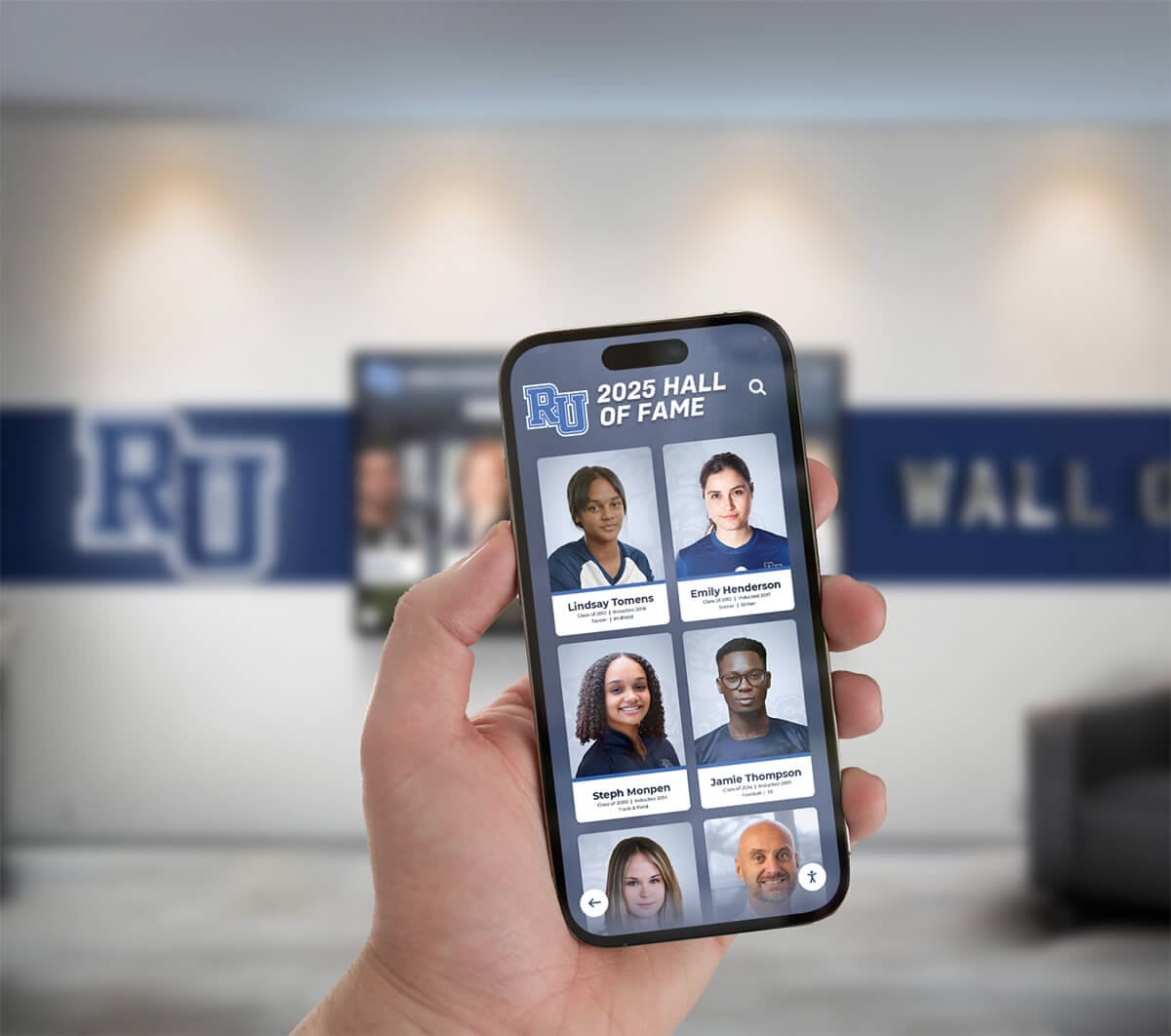
Building Community and Connections: Interactive displays facilitate alumni networking by helping constituents discover classmates they lost touch with, learn about notable graduates from their eras, identify fellow alumni working in similar fields, and connect their personal stories to broader institutional narratives.
These networking features create value for alumni beyond recognition alone. When platforms serve both recognition and networking purposes, they generate more consistent usage while building the community connections that ultimately drive philanthropic support.
Increasing Fundraising Effectiveness and Revenue
The ultimate measure of advancement solution effectiveness appears in fundraising results. Interactive recognition platforms deliver measurable improvements across multiple fundraising dimensions.
Major Gift Cultivation Support: Development officers incorporate recognition displays into campus tours with major gift prospects, demonstrating how the institution celebrates significant contributions and providing tangible visualization of the visibility donors receive. This concrete demonstration of recognition practices helps prospects envision their own legacy and the institutional impact of transformative gifts.
Institutions implementing comprehensive interactive recognition report 20-35% increases in gifts over $25,000 in the three years following platform launches—demonstrating the powerful impact of effectively communicating recognition practices during cultivation conversations.
Planned Giving and Legacy Programs: Interactive displays powerfully support legacy and planned giving programs through recognition features celebrating established donors that model giving behavior, video testimonials from planned giving donors sharing motivations that inspire similar commitments, recognition society galleries showcasing communities of legacy donors, and multi-generational giving stories demonstrating families’ sustained institutional commitment.
These elements help prospects understand that planned giving represents normal, celebrated behavior within alumni communities rather than extraordinary acts beyond typical alumni engagement.
Annual Giving Momentum and Participation Growth: Strong recognition programs create positive feedback loops for annual giving where alumni see peers recognized for giving leadership and aspire to similar recognition, existing donors feel validation reinforcing continued support, lapsed donors reconnect with institutional communities inspiring renewed giving, and first-time donors establish patterns potentially lasting decades.
Educational institutions implementing interactive recognition typically report 15-25% gains in donor retention among recognized contributors and 10-15% growth in average gift sizes within two years of implementation.
Operational Efficiency and Time Savings
Beyond donor-facing benefits, interactive advancement solutions deliver substantial operational efficiencies that free staff capacity for high-value activities directly impacting fundraising outcomes.
Streamlined Recognition Administration
Traditional donor recognition creates substantial operational burden for advancement teams. Coordinating with vendors for new plaques typically requires 8-12 weeks from decision to installation, with costs ranging from $150-400 per donor depending on materials and complexity. Each update cycle involves design review, production coordination, installation scheduling, and quality verification—processes consuming 15-25 hours of staff time monthly for active recognition programs.
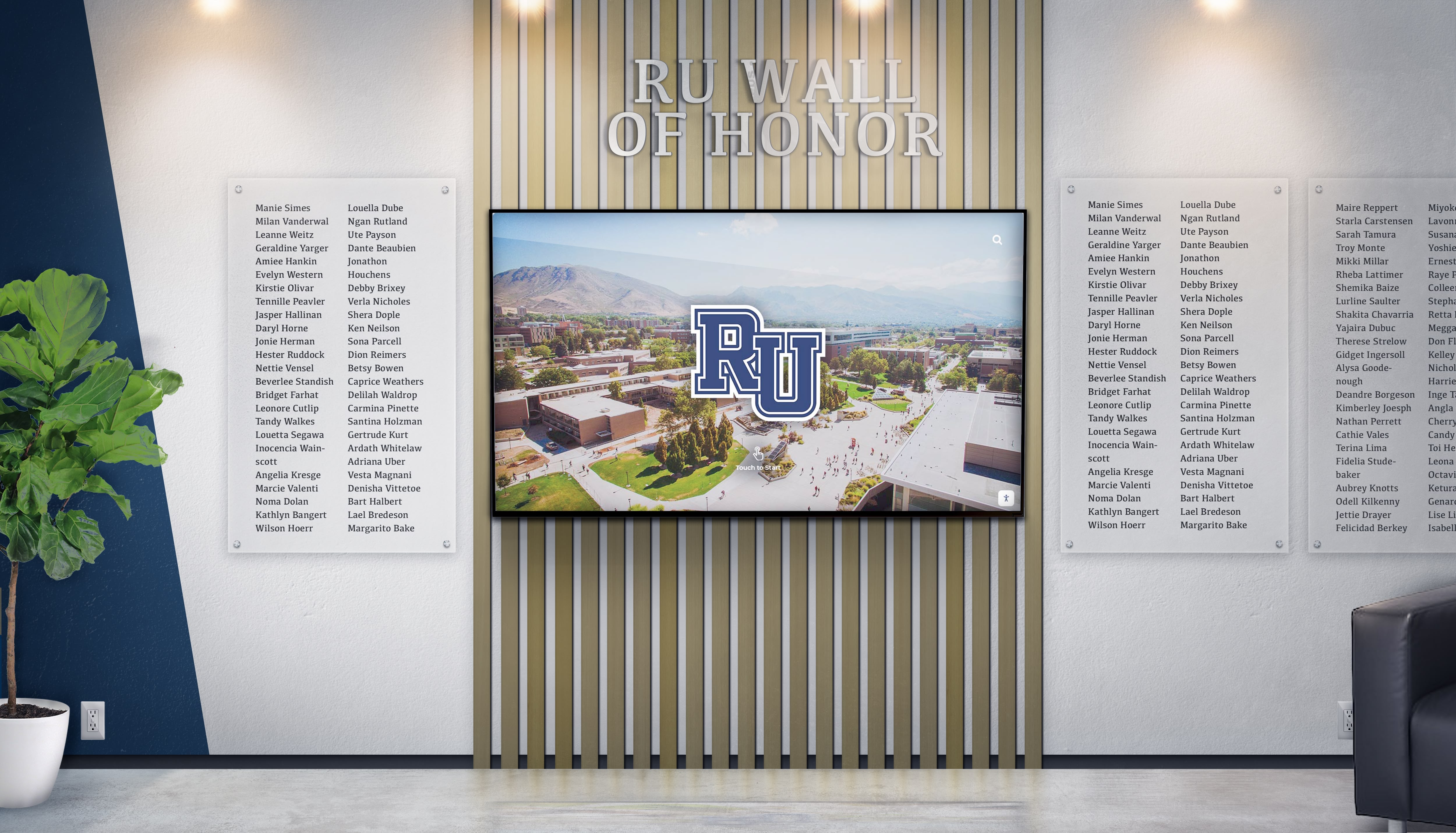
Instant Recognition Updates: Digital platforms enable advancement teams to add new donors to recognition displays within minutes of gift processing—creating immediate recognition that strengthens stewardship effectiveness. Update processes that traditionally required vendor coordination, multi-week production timelines, and installation appointments now happen through intuitive content management interfaces accessible from any device.
Quantifying Time Recovery: Advancement teams implementing digital recognition typically report 60-80% reductions in time spent managing donor recognition programs. A team spending 20 hours monthly on recognition updates recovers approximately 190 hours annually after implementing digital systems—the equivalent of adding nearly 0.1 FTE capacity without additional hiring.
For small teams where every hour matters, this recovered capacity enables expanded programming or more intensive donor cultivation that directly impacts fundraising outcomes. Time savings only deliver value when strategically redeployed toward activities with direct fundraising impact: conducting additional donor visits, deepening prospect research, enhancing personalized stewardship, expanding volunteer cultivation, or developing new giving programs.
Centralized Content Distribution
Modern advancement requires coordinated presence across multiple channels: physical displays, websites, social media, email, printed materials, and event presentations. Interactive recognition platforms enable efficient multi-channel content distribution eliminating redundant work.
Single-Source Publishing: Content created once through digital platforms can automatically flow to all connected channels—on-campus displays, web portals, mobile apps, social media, and event presentations—ensuring consistency while eliminating the need to recreate or reformat materials for different distribution methods.
For advancement teams managing donor recognition, alumni profiles, campaign content, and event information across numerous touchpoints, centralized content management represents transformational efficiency—reducing content production time by 40-50% while ensuring message consistency that strengthens institutional branding.
Automated Approval Workflows: Pre-designed templates for donor profiles, impact stories, and campaign updates maintain visual consistency while accelerating content creation. Automated approval workflows route content to appropriate reviewers based on type and subject, track approval status to prevent bottlenecks, and maintain audit trails documenting who approved what content and when.
Integration with Advancement Technology Ecosystems
Interactive recognition platforms deliver maximum value when integrated with existing advancement systems—creating seamless data flows that eliminate duplicate entry and ensure information consistency.
CRM and Database Synchronization: Many recognition platforms integrate with common advancement databases including Raiser’s Edge, Blackbaud, Salesforce for Higher Education, and Ellucian systems. These integrations enable automatic profile updates when constituent data changes, gift-triggered recognition display updates, pledge payment tracking reflected in recognition status, and synchronized demographic information.
Integration eliminates duplicate data entry across multiple systems while ensuring single sources of truth for constituent information. When donors update contact details, make gifts, or adjust recognition preferences, changes automatically propagate to all connected systems—maintaining accuracy without manual intervention.
Event Management Connections: Advancement events provide natural opportunities to feature relevant recognition content tailored to attendees. Integration with event management systems enables automatic content customization—displaying reunion year alumni during reunion weekends, featuring scholarship donors during recipient events, highlighting capital campaign supporters during facility dedications, and showcasing society members during recognition dinners.
Data-Driven Insights and Strategic Intelligence
Modern advancement requires evidence-based decision making supported by comprehensive analytics. Interactive recognition platforms provide advancement teams with engagement data that traditional displays cannot offer.
Comprehensive Engagement Analytics
Interactive platforms track detailed metrics about visitor behavior, content popularity, and engagement patterns—transforming recognition from unmeasurable activities into data-rich programs that inform strategic decisions.
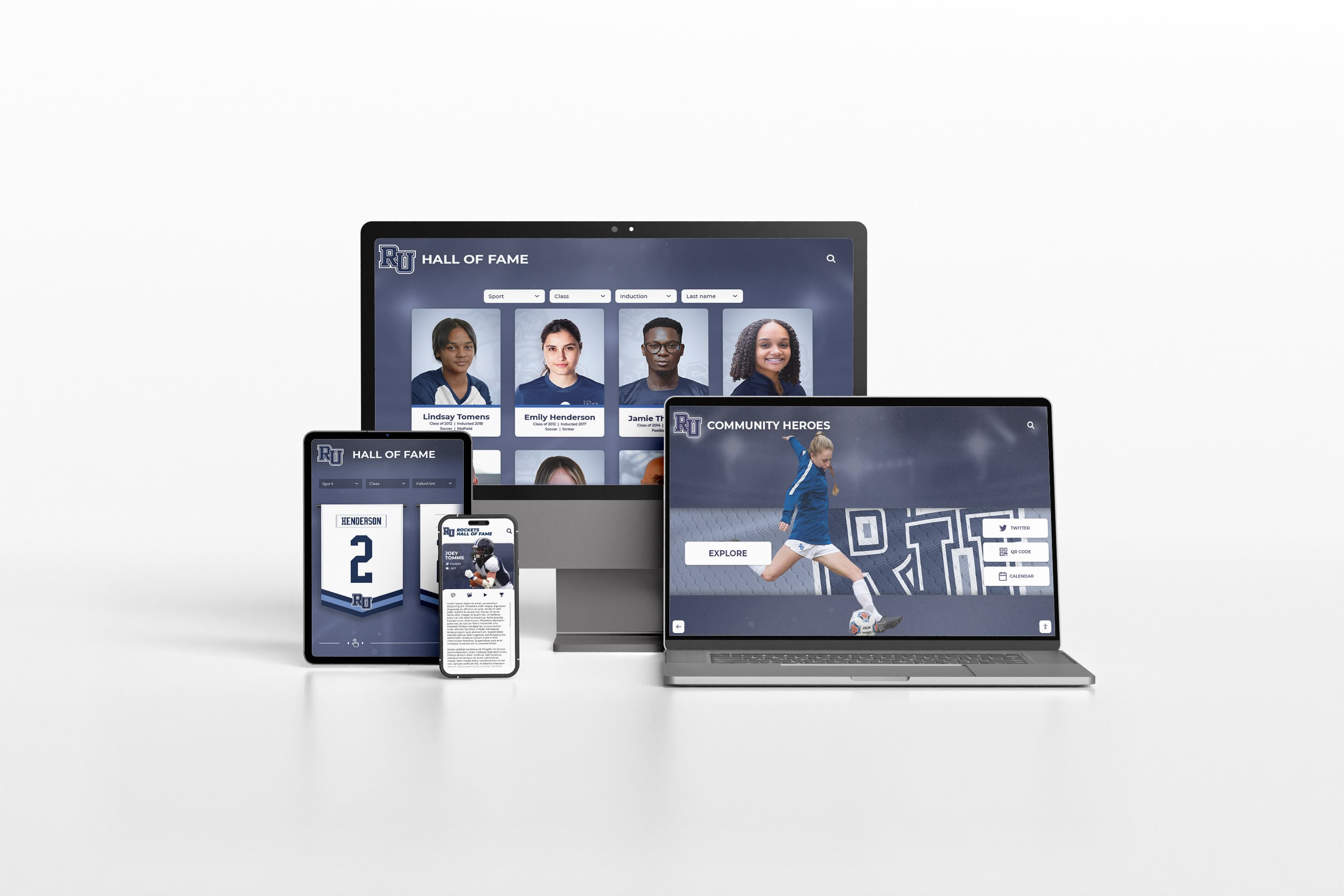
Trackable Interaction Metrics: Digital systems measure unique visitor counts revealing overall reach, session duration indicating engagement depth, pages per session showing exploration breadth, return visitor rates demonstrating sustained interest, and peak usage patterns informing optimal timing for updates and promotions.
Content Performance Intelligence: Understanding which profiles, stories, and categories generate most engagement reveals what resonates with audiences—informing future content priorities and helping advancement teams optimize recognition for maximum impact. When certain donor stories receive consistently high engagement, that signals effective approaches worth replicating. When content categories show low interaction, teams can adjust presentation or emphasis.
Search query analysis shows what visitors look for—names, years, categories, or keywords—revealing information needs and discovery challenges. If many visitors search unsuccessfully for specific content, that indicates gaps worth addressing.
Strategic Applications for Prospect Identification: While respecting privacy, behavioral signals help advancement teams prioritize outreach and tailor conversations to expressed interests. Alumni who frequently explore donor recognition may be considering their own giving—signaling prospect identification opportunities. Visitors reviewing specific program areas indicate interest alignment that can guide solicitation conversations.
ROI Demonstration for Institutional Leadership
Advancement leaders must justify program investments through data-driven evidence of effectiveness. Interactive recognition platforms provide measurable metrics that demonstrate value across multiple dimensions.
Hard Cost Savings: Digital systems eliminate recurring expenses associated with traditional recognition including plaque production costs (typically $2,000-5,000 annually for active programs), installation labor (typically $1,500-3,000 annually), and facility maintenance for physical displays. Over 10-15 year planning horizons, these avoided costs often exceed initial platform investments—creating positive financial returns before accounting for advancement outcome improvements.
Advancement Outcome Improvements: Organizations implementing digital recognition typically report several measurable improvements: 15-25% gains in donor retention among recognized contributors, 10-15% growth in average gift sizes, 20-35% increases in volunteer engagement, and 8-12% improvement in annual fund participation among targeted segments.
While isolating causation proves challenging given multiple simultaneous initiatives, institutions consistently observe these improvements following recognition platform implementations—creating strong circumstantial evidence of positive impact that justifies continued investment and expansion.
Implementation Strategy for Interactive Advancement Solutions
Successful implementation requires thoughtful planning addressing both technical and programmatic considerations to ensure sustainable operations delivering lasting value.
Phase 1: Planning and Assessment
Stakeholder Engagement: Assemble cross-functional teams including advancement leadership, IT representatives, communications professionals, alumni association leaders, and senior institutional administrators. Ensure all stakeholders understand objectives, contribute expertise, and commit necessary resources.
Needs Assessment: Evaluate current recognition programs identifying strengths worth preserving and limitations requiring new approaches. Review peer institution programs learning from others’ experiences. Survey alumni and stakeholders about recognition preferences and expectations. Analyze institutional data revealing engagement patterns and opportunity areas.
Goal Definition: Establish specific, measurable objectives such as increase alumni giving participation by 12%, improve reunion attendance by 20%, expand recognition capacity to honor 300 additional alumni annually, enhance diversity and inclusion in recognition practices, and strengthen recruitment through compelling achievement demonstration.
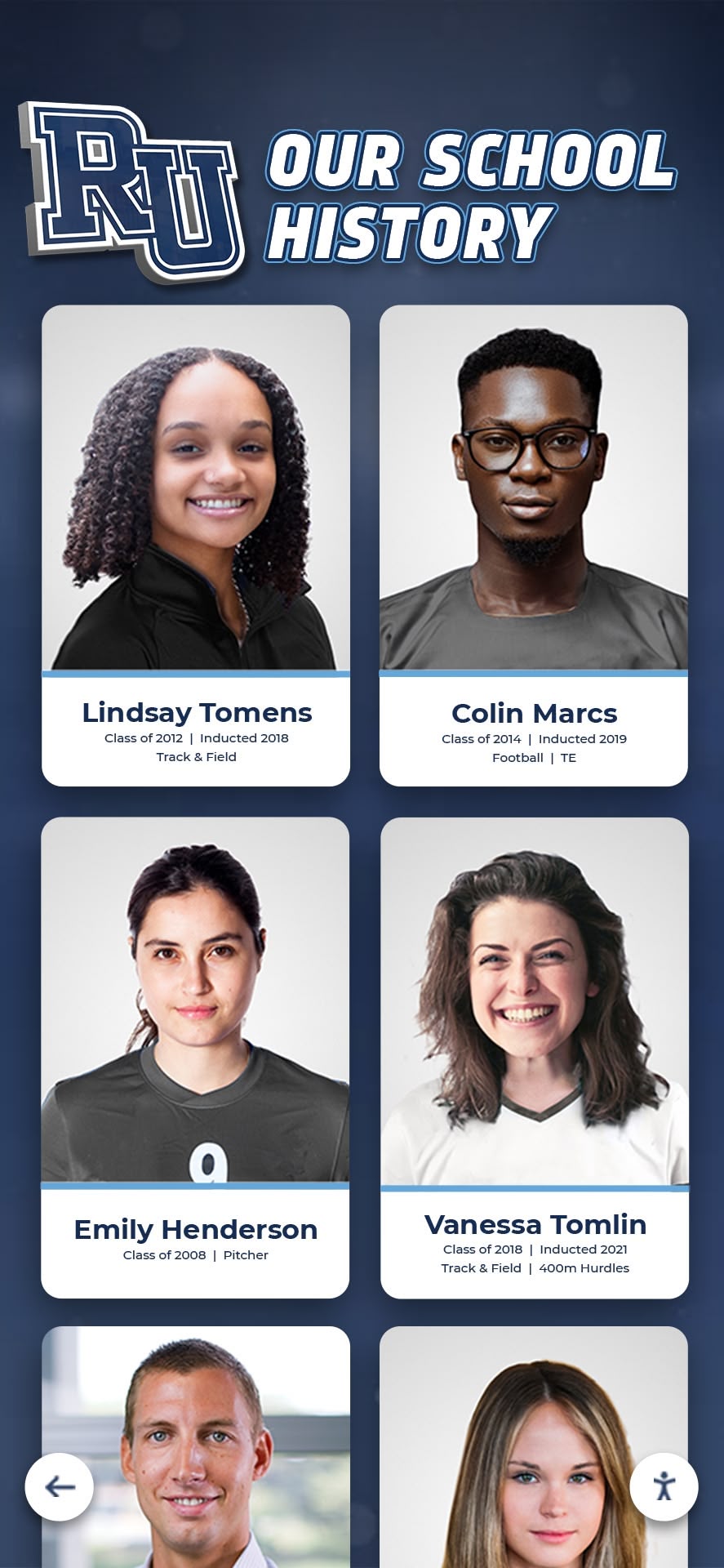
Budget Development: Calculate total investment requirements including initial hardware and software costs ($15,000-$45,000 depending on scale), content development expenses, installation and infrastructure, staff time for project management and implementation, and ongoing annual operating costs ($3,000-$8,000 for hosting, support, and maintenance).
Phase 2: Content Development
Initial Honoree Selection: Apply established criteria selecting first honoree group (typically 50-200 profiles for launch), ensuring diverse representation across achievement categories, eras, and demographics. Balance historical recognition with contemporary honorees while prioritizing living alumni who can assist with content development.
Content Gathering: Systematically collect biographical information, professional photos, video interviews when possible, archival images and documents, achievement documentation, and permissions for content use and contact information display.
Content Creation Standards: Write compelling biographical narratives (300-800 words per profile) that tell stories rather than list facts. Edit and optimize photos for display. Produce and edit video content when feasible. Organize supporting documents and media. Implement consistent formatting and style. Conduct fact-checking ensuring accuracy.
Content development typically represents the most time-intensive implementation phase but creates lasting value through rich institutional archives benefiting recognition and broader advancement communications for years to come.
Phase 3: Technical Implementation
Platform Selection and Customization: Evaluate solution providers requesting demonstrations and speaking with current users. Select platforms balancing functionality with budget and technical capacity. Configure systems with institutional branding and design preferences. Set up administrative accounts and permissions. Integrate with existing databases or systems when applicable.
Working with recognition specialists like Rocket Alumni Solutions streamlines implementation through proven platforms, established best practices, and experienced support teams that understand advancement needs.
Hardware Procurement and Installation: Select appropriate display sizes for planned locations. Choose mounting approaches (wall-mounted, freestanding kiosks, or custom enclosures). Ensure network connectivity. Install displays professionally. Test all functionality thoroughly. Train staff on basic operations.
Content Migration and Testing: Import all honoree content into the platform. Verify formatting and display across all screens. Test search and filtering functionality. Validate video and multimedia playback. Ensure mobile and web platform synchronization. Conduct user acceptance testing with representative audiences.
Phase 4: Launch and Promotion
Coordinated Launch Campaign: Execute multichannel promotion through email announcements to all alumni, social media campaigns featuring highlights, press releases to relevant media, campus-wide communications, and launch events with featured honorees attending.
Event Integration: Position displays prominently during homecoming, reunion weekends, and donor recognition events. Create scavenger hunt experiences where alumni locate classmates. Provide photo opportunities that attendees share on social media. Include display tours in event programming with advancement staff highlighting recent additions.
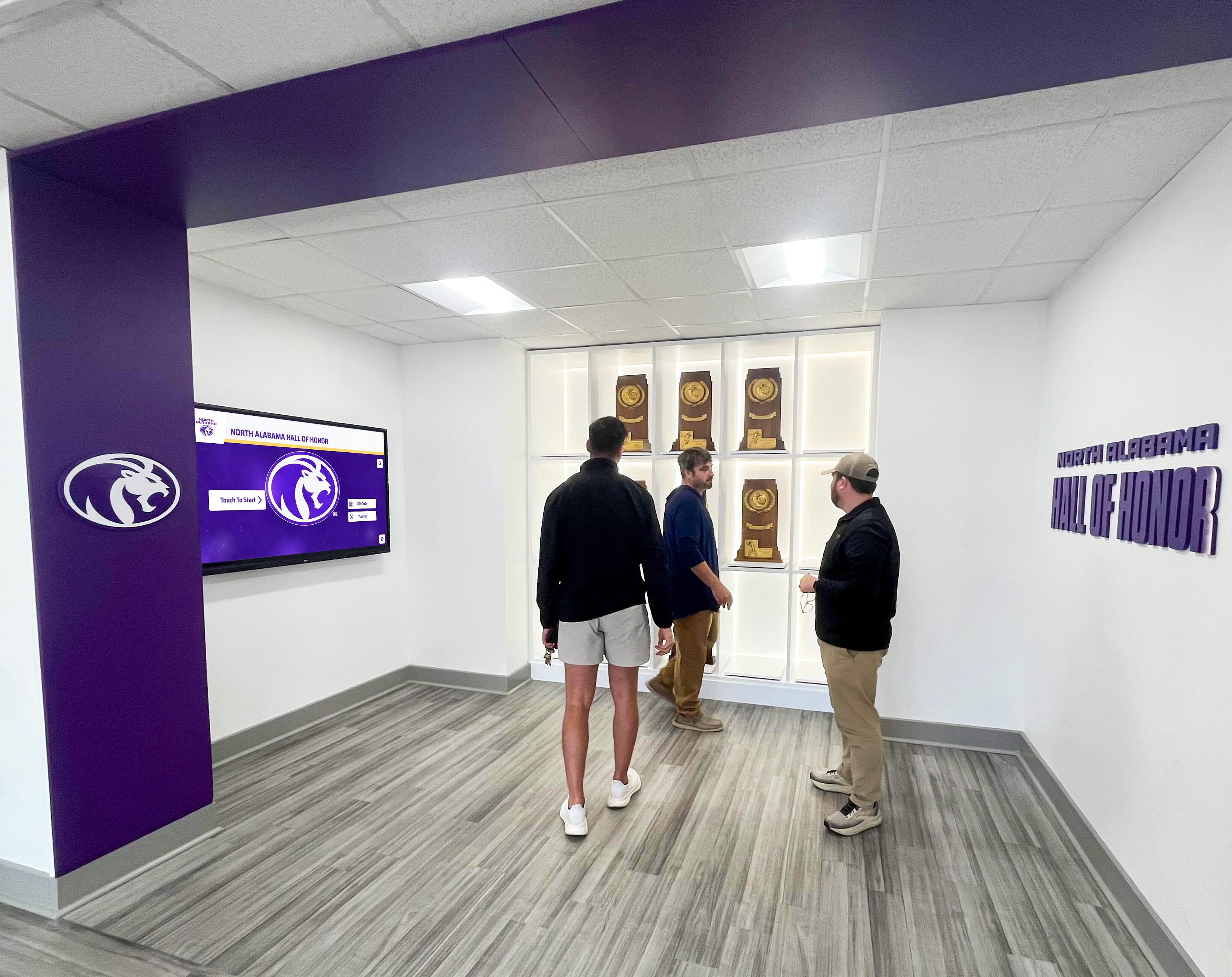
Ongoing Visibility Strategies: QR codes throughout campus directing visitors to online display components. Featured alumni spotlights in regular communications highlighting different honorees monthly. Email signature links from advancement staff directing to recognition content. Campus tour integration where admission guides showcase displays to prospective students and families.
Phase 5: Sustained Operations
Regular Content Updates: Add new honorees on predictable cycles (annual, quarterly, or rolling). Enhance existing profiles with new information or media. Rotate featured content maintaining freshness. Respond to honoree updates about career changes or achievements. Address any content corrections or updates.
Analytics Review and Optimization: Monitor engagement metrics identifying strong and weak content performance. Adjust content strategy based on data insights. Optimize search and navigation based on user patterns. Enhance high-traffic profiles with additional multimedia. Report results to stakeholders demonstrating program value.
Community Engagement: Solicit nomination suggestions from alumni communities. Involve honorees in recruitment and advancement activities. Create alumni networking opportunities through recognition platforms. Gather testimonials about recognition program impact. Celebrate milestone moments (1000th profile, anniversary, etc.).
Technical Maintenance: Ensure software updates and security patches. Conduct periodic hardware inspections. Refresh content management training for new staff. Troubleshoot any technical issues promptly. Plan for eventual hardware refresh cycles (typically 5-7 years).
Best Practices for Content That Engages
Technology enables engagement, but compelling content creates it. Strategic content development separates displays that become institutional fixtures from those that see declining use after initial novelty wears off.
Telling Stories That Resonate
Recognition content that engages emotionally tells stories rather than listing facts. Effective profiles answer questions visitors actually care about.
Overcoming Obstacles: Compelling narratives acknowledge challenges: first-generation college students navigating unfamiliar educational systems, students overcoming learning disabilities or health challenges, or professionals entering fields where their backgrounds were uncommon. Obstacle narratives create relatability—visitors see their own challenges reflected in honoree experiences, inspiring belief that similar success remains possible despite current difficulties.
Connecting Achievement to Institutional Experiences: Link accomplishments to specific institutional elements: professors who provided crucial mentorship, programs that developed specific capabilities, experiences that clarified career direction, relationships formed that evolved into professional partnerships, and institutional values internalized that guided subsequent choices.
These connections demonstrate educational impact while validating institutional missions and programs—creating powerful narratives for recruitment, fundraising, and broader stakeholder communications.
Demonstrating Impact: Achievement significance becomes clear through impact demonstration: patients helped through medical innovation, students taught and mentored, policies changed through advocacy, businesses built employing thousands, research advancing scientific understanding, art creating cultural impact, or communities served through nonprofit leadership.
Impact narratives elevate recognition beyond individual success to societal contribution—honoring accomplishment while demonstrating institutional graduates’ broader positive influence on communities and professions.
Leveraging Multimedia for Emotional Connection
Rich media transforms text-heavy profiles into engaging multimedia experiences that sustain visitor attention and create emotional connections.
Professional Photography: High-quality images prove essential for professional presentation. Professional portraits with appropriate lighting and backgrounds create consistency. Action and context photos showing honorees engaged in their work add authenticity and interest. Historical images from institutional years create nostalgia while providing context showing how honorees looked during educational experiences.
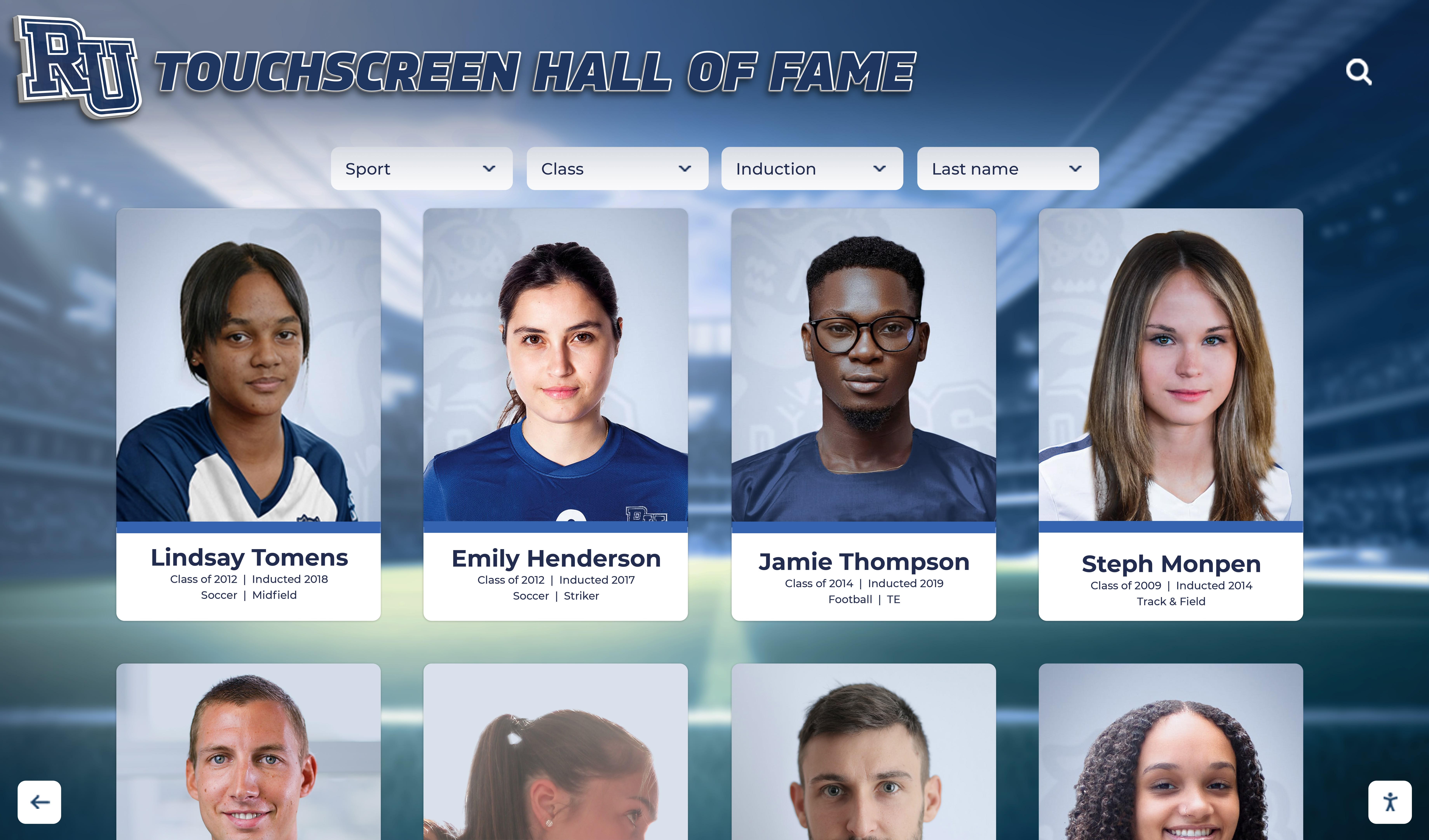
Video Content Production: Video brings honoree voices directly to audiences, creating emotional connection that text alone cannot achieve. Structured conversations covering personal background and educational experiences, career journey narratives explaining key decisions and transitions, achievement highlights describing specific accomplishments, reflections on institutional impact, and advice for current students create compelling content.
Even simple smartphone-recorded interviews edited modestly engage far more powerfully than text-only profiles, making video accessible for institutions lacking professional production capabilities.
Supporting Archival Materials: Speeches or presentations from induction ceremonies, historical radio interviews or news coverage, oral history recordings from older honorees, scanned historical documents or certificates, news clippings and media coverage, and statistical records provide research value while creating immersive recognition experiences.
Maintaining Fresh and Relevant Content
Sustained engagement requires strategic content refresh and promotion practices that give alumni reasons to return.
Predictable Induction Cycles: Add new honorees annually or quarterly, creating anticipation and giving alumni reasons to return checking for new inductees from their eras or achievement categories.
Rotating Featured Content: Highlight different honorees monthly through homepage features, email spotlights, or social media campaigns ensuring regular visibility for diverse alumni rather than the same profiles receiving perpetual prominence.
Progressive Content Enhancement: Existing profiles gain additional content over time—recent interviews added to historical profiles, career updates as alumni achieve new milestones, or newly discovered archival photos enriching earlier thin profiles.
Themed Content Collections: Organize content around timely topics like Black History Month highlighting African American alumni achievement, Women’s History Month featuring women leaders, or Homecoming showcasing athletic legends.
Integration with Comprehensive Advancement Strategy
Interactive recognition displays function most effectively as components of holistic advancement programs rather than standalone initiatives.
Supporting Campaign Management and Visibility
Capital campaigns and major initiatives require sustained visibility and momentum-building throughout multi-year timelines. Digital displays serve as dynamic campaign headquarters keeping goals visible, progress transparent, and accomplishments celebrated.
Real-Time Campaign Tracking: Digital campaign displays show real-time progress toward goals through dynamically updated thermometers, progress bars, and milestone markers that create excitement and urgency. As gifts are processed and totals climb toward targets, displays automatically update to reflect current status—providing visible evidence of campaign momentum that encourages additional participation.
Leadership Gift Recognition: Prominently featuring leadership and pace-setting gifts creates social proof encouraging others to similar giving levels. When prospects see peers making major commitments, it normalizes leadership giving and demonstrates that transformative philanthropy represents normal behavior within institutional communities.
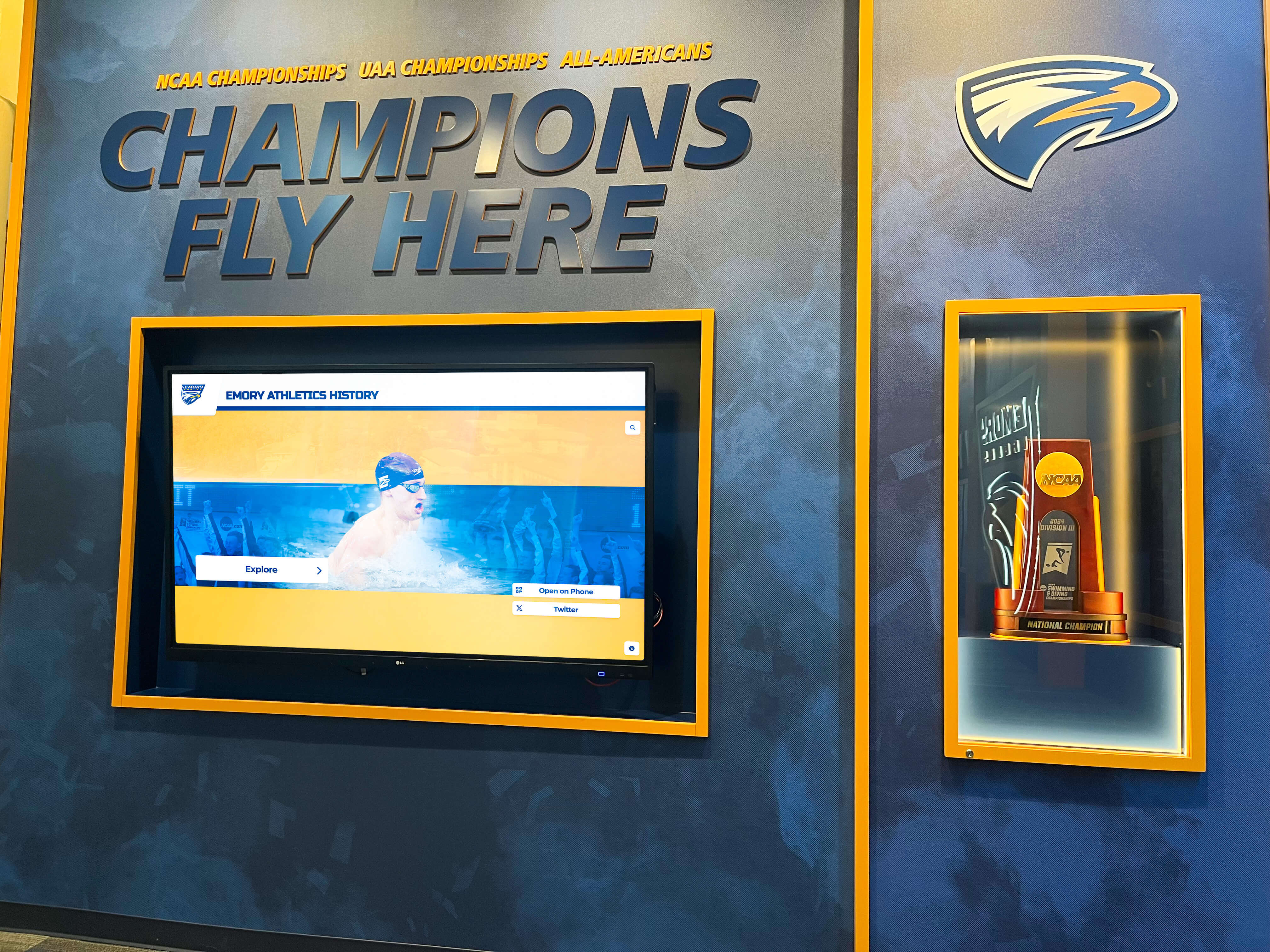
Flexible Campaign Phases: Multi-year campaigns typically progress through distinct phases—quiet, public, momentum, and completion—each requiring different emphasis and messaging. Digital platforms adapt instantly to phase transitions, highlighting relevant themes, featuring appropriate content, and adjusting prominence as campaigns evolve.
Coordinating with Alumni Events
Strategic institutions leverage recognition displays as event focal points that facilitate meaningful interactions and strengthen community bonds.
Reunion Weekend Integration: Feature era-specific content highlighting honorees from reunion classes. Create scavenger hunt experiences where alumni locate classmates in the display. Provide photo opportunities at displays that attendees share on social media. Include display tours in reunion programming. Gather additional content from reunion attendees updating profiles.
Homecoming Celebrations: Spotlight athletic achievements and traditions connecting to homecoming themes. Host induction ceremonies for new honorees during homecoming events. Create interactive experiences where attendees vote for favorite historical moments. Generate social media content featuring display highlights that build pre-event excitement.
Donor Recognition Events: Showcase recognized donors demonstrating how institutions celebrate generosity. Feature honorees who are also significant contributors connecting recognition to giving. Use video content from displays during program presentations. Provide private display access during exclusive donor events.
Events provide natural opportunities for content gathering—recording interviews, taking professional photos, and collecting updated information—while displays give events compelling focal points that facilitate conversation and strengthen community feeling.
Extending Recognition Through Digital Channels
Physical displays reach on-campus visitors, but web and mobile extensions extend recognition globally to alumni who may never return to campus physically.
Online Recognition Platforms: Companion websites enable remote access providing all display content in web-optimized formats. Advanced search and filtering match physical display capabilities. Personalized experiences allow alumni to create accounts and save favorites. Social features enable commenting, sharing, or connecting with honorees.
Mobile Applications: Dedicated apps or mobile-optimized websites enable engagement anywhere through searchable alumni directories, event integration providing relevant recognition during gatherings, notification systems alerting users when new honorees from their eras are added, and networking features facilitating connections among alumni.
Mobile platforms meet alumni where they spend most digital time—on smartphones—increasing engagement frequency by reducing friction between intention and action.
Social Media Integration: Regular featured alumni posts highlighting different honorees, video content snippets from interviews optimized for social platforms, user-generated content campaigns encouraging alumni to share their own stories, recognition announcement campaigns when new honorees are added, and anniversary posts celebrating historical achievements amplify recognition impact beyond institutional channels.
Overcoming Common Implementation Barriers
Advancement teams considering interactive solutions often encounter concerns that prevent adoption. Understanding and addressing these barriers helps institutions move forward confidently.
Budget Constraints and Funding Approaches
While initial investments appear substantial—typically $25,000-65,000 for comprehensive installations including hardware, software, content development, and implementation services—several approaches make recognition platforms financially feasible.
Phased Rollouts: Start with single displays in high-priority locations to reduce initial costs while proving value that justifies expansion. Begin with web-based recognition platforms ($8,000-$15,000) before adding physical displays once fundraising returns demonstrate value.
Donor Sponsorship: Campaign donors often fund recognition systems themselves—“sponsor the donor wall” opportunities appeal to supporters seeking visible impact. When recognition platforms become campaign components funded through designated gifts, budget barriers disappear.
Multi-Year Budget Allocations: Spread costs across fiscal years, making annual impacts manageable within constrained budgets. Return on investment analysis showing that platforms pay for themselves through recovered staff time and improved fundraising outcomes within 2-4 years helps justify initial investments.
Technology Concerns and User-Friendliness
Non-technical advancement professionals may worry about system complexity and ongoing management requirements. Modern platforms address these concerns through intuitive interfaces requiring no technical expertise, comprehensive training during implementation, responsive support for troubleshooting, automatic updates requiring no IT involvement, and cloud-based management accessible from any device.
Purpose-built advancement platforms prioritize user-friendliness specifically for non-technical users—recognizing that advancement staff need tools that just work rather than systems requiring technical expertise to operate effectively.
Content Development Capacity
Teams wonder whether they have capacity to populate and maintain recognition platforms. Practical approaches make content development manageable: phased content addition starting with priority populations rather than attempting comprehensive completion before launch, student employment engaging undergraduates in content development and donor research, alumni crowdsourcing inviting profile submissions directly from constituents, existing content repurposing from printed materials and websites, and template standardization simplifying ongoing additions.
Most institutions find that initial setup requires moderate effort during implementation phases, but ongoing maintenance demands far less time than traditional recognition methods—creating net time savings despite digital content requirements.
Future Trends in Interactive Advancement Technology
Understanding emerging trends helps institutions implement solutions that remain relevant and valuable long-term rather than becoming outdated as technology and expectations evolve.
Artificial Intelligence and Personalization
AI capabilities increasingly enhance recognition experiences through intelligent personalization matching visitor interests to relevant content.
Smart Content Recommendations: Machine learning algorithms analyze viewing patterns suggesting “you might also be interested in” content based on profiles visitors have viewed. Alumni exploring profiles from their graduation years might receive suggestions for classmates they knew, while visitors viewing medical professionals see other healthcare innovators.
Natural Language Search: Rather than requiring precise name spelling or category knowledge, conversational search accepts queries like “Show me engineers who graduated in the 1990s” or “Find alumni who work in environmental conservation,” making discovery more intuitive and accessible.
Automated Content Enhancement: AI tools assist with biographical writing, photo enhancement and restoration, video transcription and captioning, content tagging and categorization, and relationship mapping between honorees with common backgrounds or achievements—reducing administrative burden while improving content quality.
Augmented and Virtual Reality Integration
Immersive technologies create novel recognition experiences connecting physical and digital environments.
Augmented Reality Enhancements: Smartphone apps using AR technology allow visitors to point devices at physical displays unlocking additional digital content layers—videos, 3D visualizations, or interactive timelines—that blend physical and digital elements into unified experiences.
Virtual Reality Experiences: VR technology creates immersive recognition environments for remote alumni, providing virtual campus tours featuring recognition displays, attendance at induction ceremonies from anywhere globally, and interactive historical experiences showing institutional evolution through alumni achievement.
Enhanced Integration with Advancement Systems
Future platforms will offer deeper integration with advancement technology ecosystems, creating seamless workflows between recognition, fundraising, communications, and event management systems. Bi-directional data synchronization, automated giving triggers, and consolidated reporting will eliminate manual processes while providing comprehensive views of constituent engagement across all institutional touchpoints.
Measuring Success and Demonstrating ROI
Comprehensive ROI assessment combines technology analytics, advancement metrics, and qualitative feedback to demonstrate value and inform continuous improvement.
Technology Analytics
Interactive platforms provide direct engagement metrics including unique visitor counts and traffic trends over time, average session duration revealing content engagement depth, pages per session showing exploration breadth, most-viewed profiles and categories indicating what resonates, search query patterns revealing discovery behaviors, and return visitor rates demonstrating sustained interest.
Advancement Outcome Metrics
Connect recognition to advancement outcomes by tracking alumni giving participation rates before and after implementation, average gift sizes for engaged alumni versus non-engaged populations, major gift proposal success rates for prospects exposed to recognition displays during cultivation, first-time donor acquisition among recently recognized alumni, planned giving inquiries correlation with recognition program visibility, and volunteer program participation changes following recognition launches.
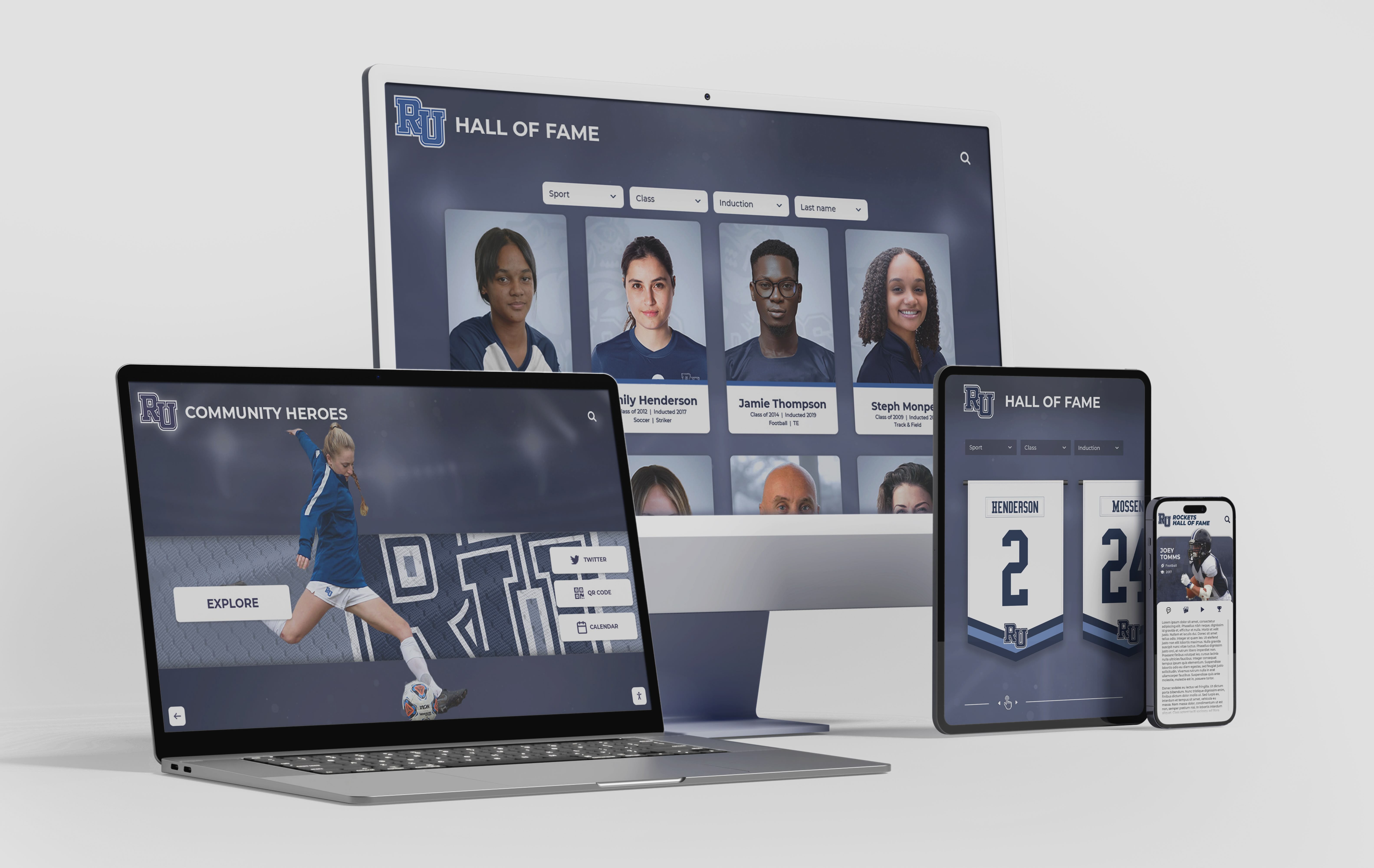
Broader Institutional Impacts
Assess recruitment metrics including prospective student feedback mentioning displays, application and yield rate correlations with campus visit experiences, and admissions counselor reports. Measure event attendance comparing homecoming, reunion, and alumni program participation before and after implementation. Track communication engagement measuring email open rates, website traffic to alumni pages, and social media interaction on alumni content.
Qualitative Feedback
Gather insights through brief on-screen surveys after interactions, focus groups with diverse alumni stakeholders, social media monitoring for spontaneous reactions, testimonials from recognized honorees, and advancement officer observations about donor and prospect responses.
Most institutions establish baseline metrics before implementation then assess changes at 6, 12, 18, and 24 months post-launch. Typical results show 18-24 month payback periods through fundraising increases alone before accounting for recruitment, engagement, and efficiency benefits.
Conclusion: Strategic Advancement Through Interactive Innovation
Advancement offices operate in increasingly challenging environments where efficiency, engagement, and measurable results determine success. Resource constraints, declining participation rates, rising expectations, and fierce competition create operational pressures that demand innovative solutions providing meaningful support.
Interactive advancement solutions—particularly digital recognition displays and touchscreen technology—represent powerful tools that address multiple advancement challenges simultaneously. These sophisticated platforms streamline recognition operations, enable scalable donor stewardship, support campaign management, deliver actionable analytics, and demonstrate clear return on investment.
Organizations that strategically implement interactive advancement solutions gain significant operational advantages while improving fundraising outcomes. By automating time-consuming administrative tasks, creating always-on stewardship touchpoints, and providing the data-driven insights that inform strategic decisions, these platforms empower advancement professionals to focus capacity where it matters most—building relationships, cultivating prospects, and driving philanthropic support that advances institutional missions.
The transformation from static, space-constrained recognition to dynamic, unlimited digital platforms fundamentally changes what’s possible in advancement. Educational institutions can now honor all deserving constituents rather than selecting limited numbers based on physical constraints, tell complete stories through multimedia rather than reducing achievements to brief text, update recognition instantly rather than waiting months for physical renovations, engage global alumni communities through digital extensions rather than limiting recognition to campus visitors, and measure engagement with precision rather than guessing about program impact.
Keys to Interactive Advancement Solution Success:
- Start with clear objectives connecting recognition to broader institutional priorities
- Invest in quality content development that tells compelling stories rather than listing facts
- Select technology platforms matching institutional capacity and long-term needs
- Promote recognition consistently rather than relying on initial launch enthusiasm
- Measure engagement systematically enabling continuous improvement
- Integrate recognition throughout advancement programming rather than treating as standalone initiative
- Plan for sustainability through adequate budget, staffing, and processes
- Engage honorees as active participants rather than passive subjects
For advancement teams ready to modernize operations and enhance effectiveness, solutions like Rocket Alumni Solutions provide comprehensive platforms combining intuitive technology, purpose-built advancement features, and proven best practices—making it easier than ever to implement recognition programs that deliver lasting value.
Ready to discover how an interactive advancement solution can transform your institution’s fundraising and alumni engagement? Explore modern recognition technology that honors distinguished constituents while strengthening the institutional bonds that drive sustained philanthropic support and community engagement for decades to come.




































